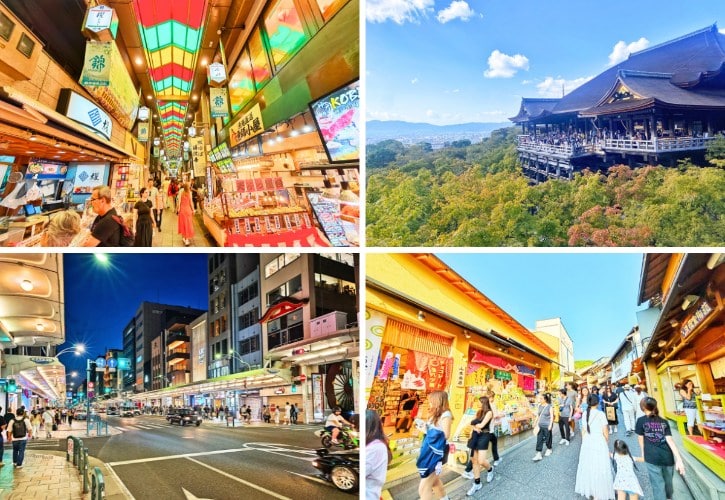
Planning a Kyoto day trip from Osaka doesn’t have to be complicated!
I’ll show you exactly how to get there and the best route for visiting popular attractions, saving you time when planning your trip.
Kyoto is just a short train ride from Osaka, perfect for exploring in a single day.
If you have more time, check out my Kyoto 3-day itinerary here. I also have another article covering an alternative route for exploring Kyoto in one day, which you can find here. 😊
9:00 AM: Kinkakuji Temple
a. Overview
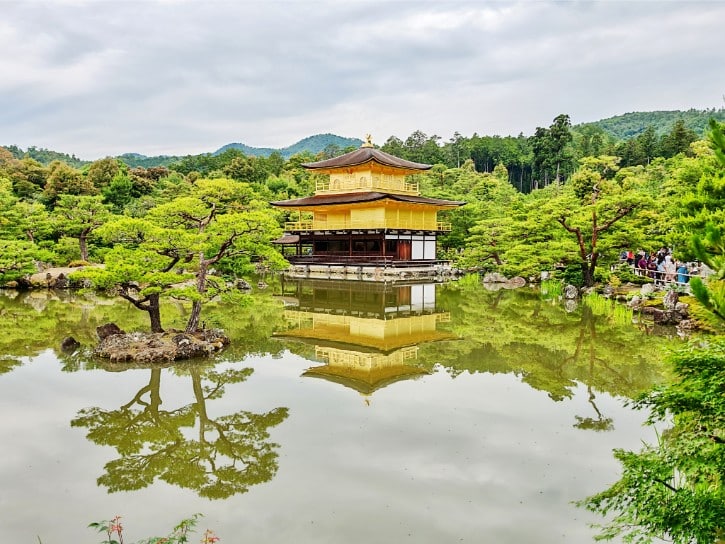
- What It Is: Kinkaku-ji is a Zen Buddhist temple in Kyoto. It’s well-known for its top two floors, which are completely covered in gold leaf. It’s a UNESCO World Heritage Site and one of Kyoto’s best-known attractions.
- History: The temple was first built in 1397 as a retirement villa for a shogun. Later, it was turned into a Zen temple. The current structure was rebuilt in 1955 after the original temple burned down in 1950.
- Why Visit: You should visit Kinkaku-ji for its beautiful appearance and peaceful atmosphere. The reflection of the golden building on the pond is something you’ll remember, especially on sunny days.
- Atmosphere: The temple area feels calm and relaxing. There are beautiful gardens and easy walking paths. Even when it’s busy, you can comfortably take your time enjoying the views.
b. Things You Won’t Want to Miss at Kinkaku-ji
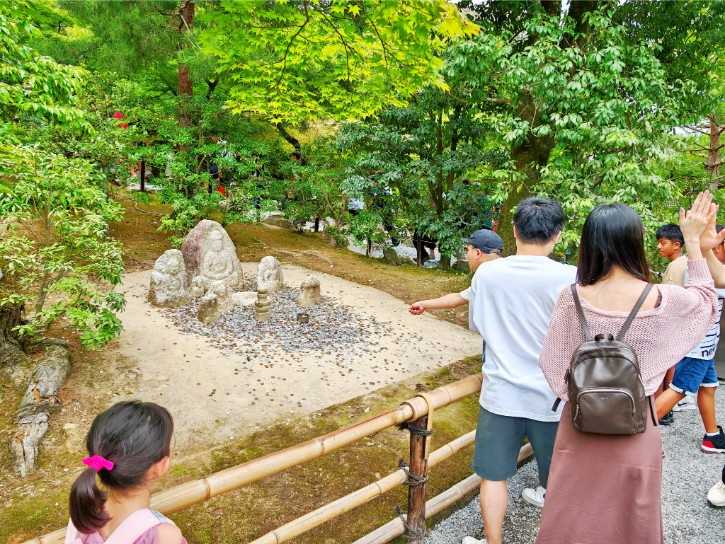
- Coin Tossing for Good Luck: Near the Golden Pavilion, you’ll see small statues. Toss a coin into the bowl at the base of these statues and make a wish for protection and good luck.
- Enjoy the Reflection of the Golden Pavilion: Take your time to appreciate the reflection of the golden temple on Kyoko-chi Pond. On calm days, the water clearly mirrors the pavilion, making it extra beautiful.
- Visit Anmintaku Pond: Stop by this serene pond, which always has water. In the middle, you’ll see a small island dedicated to the white snake, which symbolizes water. There’s also a small five-ringed pagoda monument standing in the pond.
c. How to Get from Osaka to Kinkakuji Temple
i. From Namba
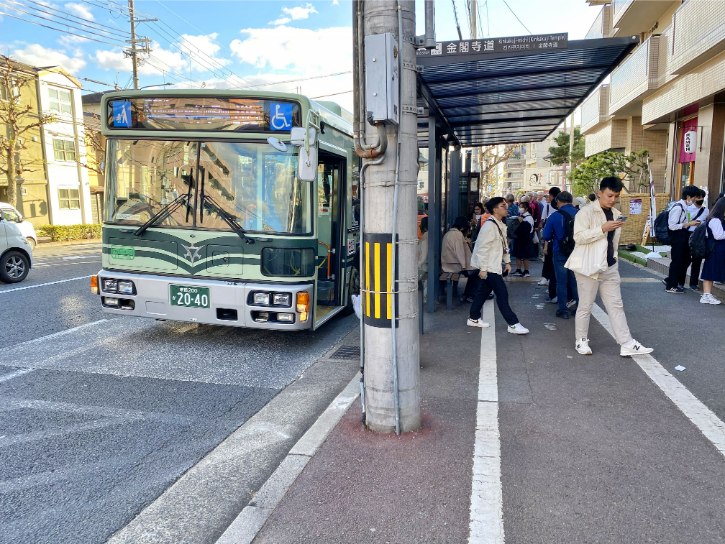
- From Namba Station, take the Osaka Metro Midosuji Line to Umeda Station.
- Walk from Umeda Station to Osaka-Umeda Station.
- From Osaka-Umeda Station, take the Hankyu Kyoto Main Line Limited Express train to Saiin Station.
- Exit Saiin Station via the West Exit and walk to the Nishioji Shijo bus stop.
- Take Kyoto City Bus No. 205 to Kinkakuji-michi bus stop.
- From Kinkakuji-michi bus stop, walk about 2 minutes to reach Kinkakuji Temple.
- The entire journey takes about 1 hour and 30 minutes and costs ¥880.
ii. From Umeda
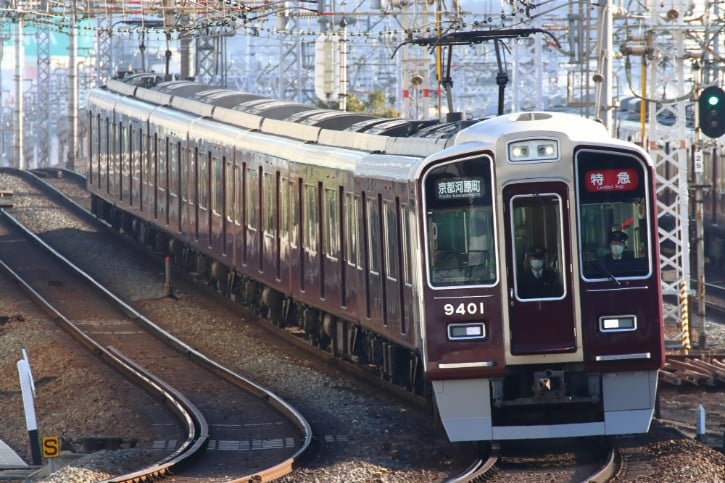
- At Osaka-Umeda Station, board the Hankyu Kyoto Main Line Limited Express train and get off at Saiin Station.
- From Saiin Station, use the West Exit and walk to the Nishioji Shijo bus stop.
- At Nishioji Shijo bus stop, take Kyoto City Bus No. 205 to Kinkakuji-michi bus stop.
- From there, walk about 2 minutes to arrive at Kinkakuji Temple.
- The entire journey takes approximately 1 hour and 10 minutes and costs ¥640.
11:15 AM: Nishiki Market
a. Overview

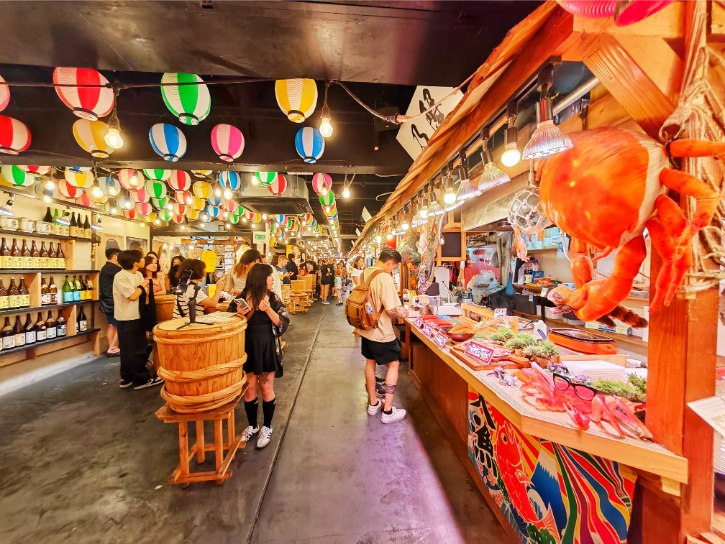
- What It Is: Nishiki Market is a narrow shopping street often called “Kyoto’s Kitchen”. It has over 100 food stalls and restaurants selling fresh seafood, fruits, vegetables, kitchen tools, knives, and local specialties.
- History: The market is more than 400 years old. It began as a fish market in the early 1600s because the area had cool groundwater that kept fish fresh. Later, the market expanded to include many other foods.
- Why Visit: You’ll get to explore Kyoto’s local food scene and try tasty street foods like grilled meats, mochi, and rolled omelets (tamagoyaki).
- Atmosphere: Nishiki Market is a lively covered street full of energy. You’ll enjoy its colorful displays and busy atmosphere, which combines tradition with excitement.
b. Must-Try Foods at Nishiki Market
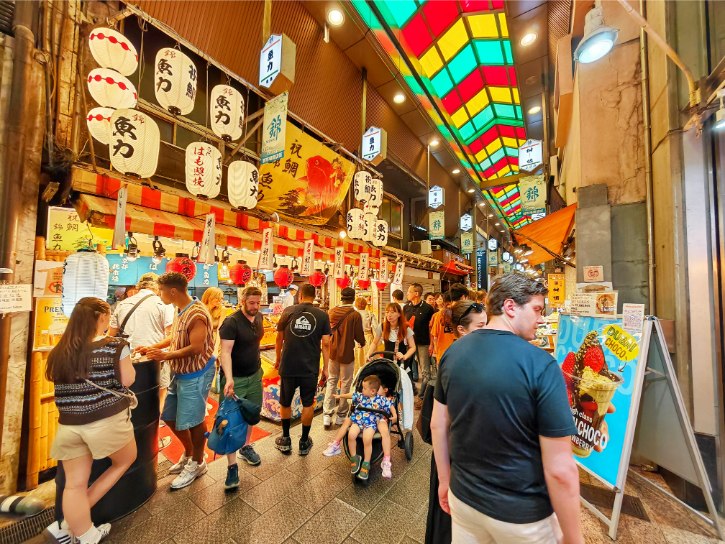
- Tai Kushi (Uoriki): Delicious grilled fish skewers made from fresh sea bream. You can choose between grilled skewers with a firmer texture that taste great with sauce, or lightly fried ones that are soft and delicate.
- Yuba Cream Croquette (Hanayori Kiyoe): Crispy croquettes made with tofu skin (yuba) and filled with creamy sauce. They’re crunchy on the outside and soft inside.
- Soy Milk Doughnuts (Konna Monja): Fresh, fluffy doughnuts made using soy milk. They have a lightly sweet taste and are best when eaten warm.
- Dashimaki Tamago – Rolled Omelet (Miki Keiran): A flavorful rolled omelet made from fresh eggs and tasty dashi broth.
- Tako Tamago – Octopus with Quail Egg (Kai): A unique snack made from a small octopus stuffed with boiled quail egg, grilled with a delicious glaze.
- Unagi – Grilled Eel (Ajisai no Toyo): Eel grilled over charcoal with a sweet soy sauce glaze, served on rice.
c. How to Get from Kinkakuji Temple to Nishiki Market
- From Kinkakuji Temple, walk to Kinkakuji-michi bus stop.
- Take Kyoto City Bus No. 205 to Shijo Kawaramachi bus stop.
- From there, walk about 5 minutes to reach Nishiki Market.
- The entire journey takes about 45 minutes and costs ¥230.
12:30 PM: Lunch
a. Kyoto Engine Ramen
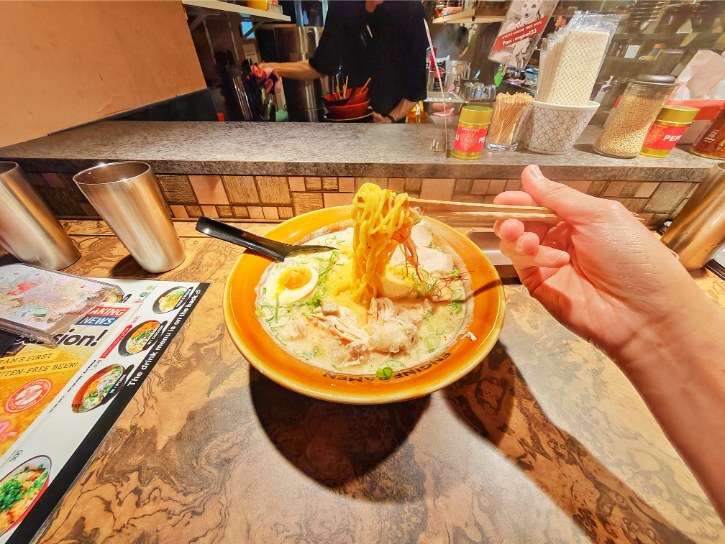
- What They Sell: Kyoto Engine Ramen specializes in ramen with three main types: Zesty (spicy miso), Genuine Miso, and Vegan options. Gluten-free noodles are available for an extra ¥200. They also offer side dishes such as miso seasoned rice and soup dumplings.
- Must-Try Dish: Try the Kyoto Zesty Ramen, featuring spicy miso soup with chicken, pork chashu, and flavorful toppings. Another highly recommended dish is the Zesty Ramen for Vegan, a creamy and spicy miso ramen with fully vegan ingredients.
- Budget: Ramen dishes typically cost between ¥1,400 to ¥1,900 per bowl. Additional toppings range from ¥100 to ¥300. Side dishes like miso seasoned rice are ¥300, and soup dumplings are ¥800 to ¥1,000.
How to Get to Kyoto Engine Ramen from Nishiki Market
It’s just a 1-minute walk from Nishiki Market to Kyoto Engine Ramen.
b. Gyukatsu Kyoto Katsugyu

- What They Sell: Delicious crispy beef cutlets called “Gyukatsu”. They’re crunchy on the outside and juicy inside. You’ll get them in a set with rice, cabbage, soup, and tasty dipping sauces.
- Must-Try Dishes: The Sirloin Gyukatsu Set and the Tenderloin Gyukatsu Set are highly recommended.
- Budget: Expect to spend about ¥2,000 to ¥3,000 per person.
How to Get to Gyukatsu Kyoto Katsugyu from Nishiki Market
It’s just a 1-minute walk from Nishiki Market to Gyukatsu Kyoto Katsugyu.
2:00 PM: Ninenzaka
a. Overview

- What It Is: Ninenzaka is a lovely historic walking street in Kyoto. It has traditional wooden buildings and stone-paved paths that give you the feeling of stepping back in time.
- History: The street has existed since the Edo period (1603–1868). It started as a path pilgrims took to reach Kiyomizu-dera Temple. Locals named it “Two-Year Hill” because of an old story that says if you trip here, you’ll get two years of bad luck. But don’t worry, that’s just a legend!
- Why Visit: You can admire beautiful traditional architecture, shop for handmade local crafts, and try delicious Kyoto-style snacks.
- Atmosphere: Walking along Ninenzaka is peaceful and relaxing. All buildings are well-preserved, and there are no visible power lines or modern distractions. It’s an ideal place for a leisurely stroll.
b. Top Places to Try Local Treats
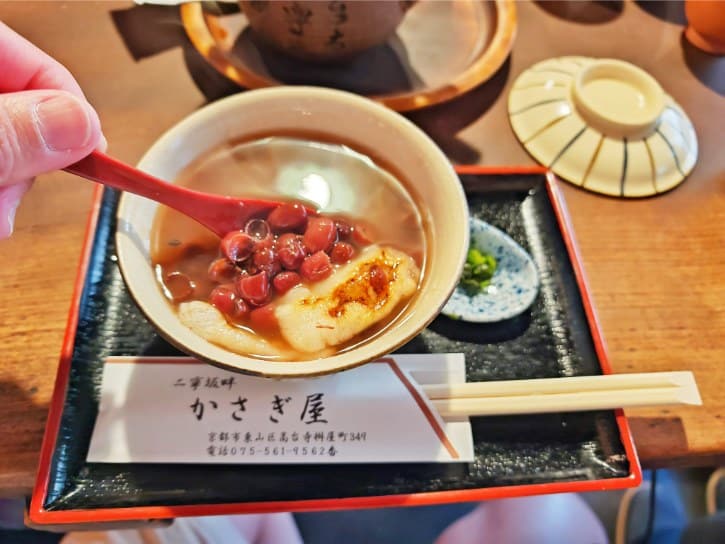
- Kasagiya: A sweets shop with a long history dating back to the Taisho era. They offer tasty traditional snacks like o-hagi (sweet rice cakes) and zenzai (sweet red bean soup).
- Starbucks Kyoto Ninenzaka Yasaka Chaya: This Starbucks is special because it blends modern coffee culture with traditional Kyoto style. You can even sit on tatami mats while enjoying your drink.
- Ishidatami: A popular shop for soft-serve ice cream. Make sure to try their rich matcha flavor topped with their own special sauce.
- Fujinami Kodai-ji Temple Store: A well-known shop selling authentic Kyoto sweets, especially handmade dango and mochi. They carefully select high-quality ingredients.
c. How to Get from the Restaurants Listed Above to Ninenzaka
- Walk to Shijo Kawaramachi bus stop.
- Take Kyoto City Bus No. 207 to Higashiyama Yasui bus stop.
- From there, walk about 8 minutes to reach Ninenzaka.
- The entire journey takes about 15 minutes and costs ¥230.
3:00 PM: Yasaka Pagoda
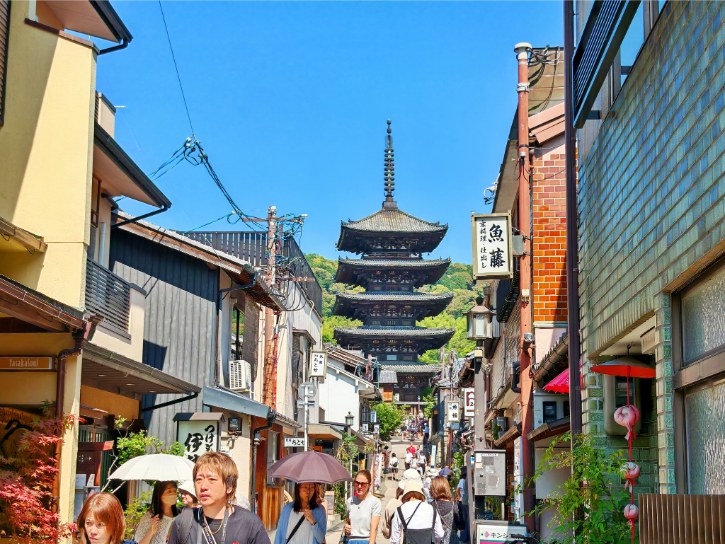
- What It Is: It’s a historic five-story pagoda known as Hokan-ji Temple, located in the Higashiyama area of Kyoto. You might have seen it before in famous pictures or postcards.
- History: The pagoda is very old, built more than 1,400 years ago in the 6th century. In the past, it was part of a larger temple area that isn’t there anymore. Fires damaged it several times, so people rebuilt it while keeping its original look.
- Why Visit: This pagoda is a great place to take beautiful photos. The traditional streets around it make the scenery even more special.
- Atmosphere: You’ll feel calm and relaxed here, with quiet sounds like gentle wind chimes.
How to Get from Ninenzaka to Yasaka Pagoda
It’s a 3-minute walk from Ninenzaka to Yasaka Pagoda.
3:10 PM: Sannenzaka
a. Overview
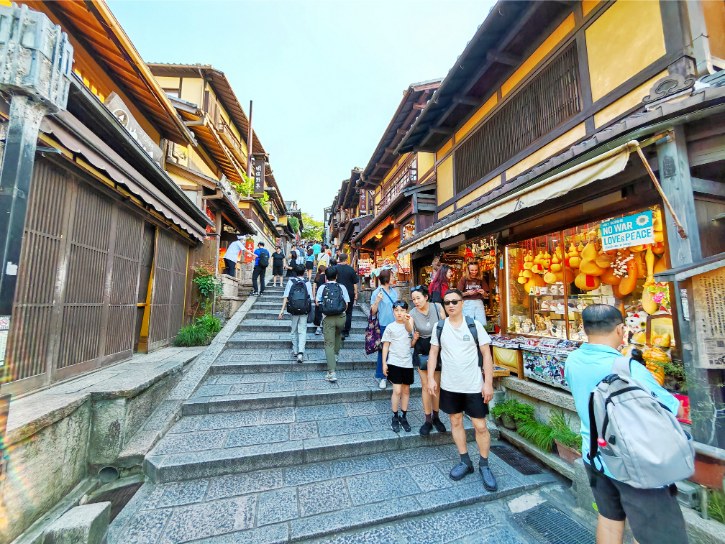
- What It Is: Sannenzaka is a historic sloping street located in Kyoto’s Higashiyama district. Traditional wooden buildings and cozy shops along the street make you feel like you’ve stepped into old Kyoto.
- History: The street is over 1,000 years old. It was originally the main path leading to Kiyomizu-dera Temple. The name “Sannenzaka” means “Three-Year Slope”. A local legend says you’ll have three years of bad luck if you slip here, but that’s just a story people tell for fun.
- Why Visit: It’s the perfect spot to enjoy traditional Kyoto charm, shop for handmade gifts, taste matcha sweets, and take lovely photos of the stone-paved paths and lanterns.
- Atmosphere: Walking here feels like stepping into Kyoto’s past. The street is lively and friendly, popular with both locals and visitors.
b. Tasty Local Treats to Enjoy

- Kirakuan Okamoto Sanneizaka: Famous for “Maiko-yaki”, tasty fried chicken snacks shaped like young geisha. Their croquettes are also delicious.
- Fujinami: This shop serves tasty Kyoto-style treats. Try their iced matcha drink and soy sauce-flavored dango, both popular local favorites.
- Okutan Kiyomizu: Well-known for fresh handmade tofu dishes. Try their special shaved ice dessert made with soy milk and black honey. It’s tasty and unique.
- Umezono Kiyomizu: This traditional sweet shop opened in 1927. They offer classic Japanese desserts such as matcha sweets, shiratama zenzai (mochi balls served with sweet red bean soup), warabi mochi, and seasonal sweets.
- Ukiya Kiyomizu Kiseian: Popular for handmade soba noodles and tasty oyakodon (rice bowl with egg and chicken). Their crispy fried shrimp oyakodon is especially good.
c. How to Get from Yasaka Pagoda to Sannenzaka
It’s a 3-minute walk from Yasaka Pagoda to Sannenzaka.
4:00 PM: Matsubara-dori
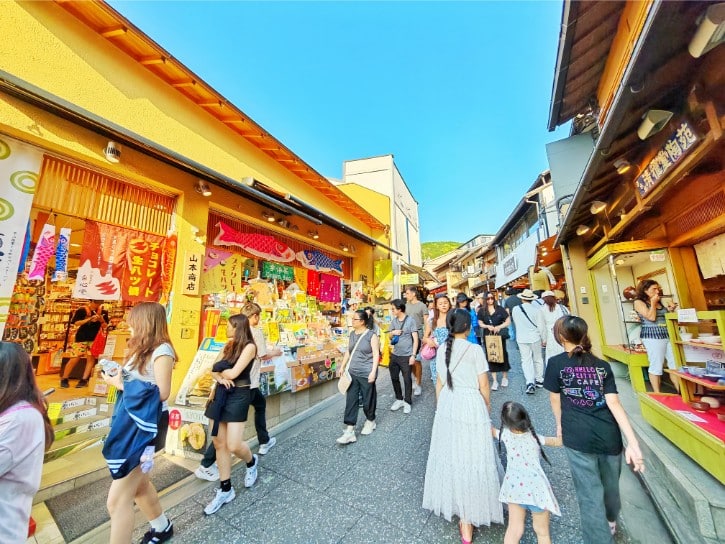
- What It Is: A charming shopping street in Kyoto’s Higashiyama district that slopes gently uphill toward Kiyomizu-dera Temple. It’s lined with traditional buildings housing various shops and eateries.
- Things to Buy: You can find colorful traditional Japanese fans, matcha sweets, ice cream, souvenirs, local snacks, and crafts such as pottery and handmade accessories.
- Atmosphere: Busy yet friendly, with tourists and locals browsing casually. The traditional setting gives it a nostalgic, welcoming vibe.
How to Get from Sannenzaka to Matsubara-dori
It’s a 1-minute walk from Sannenzaka to Matsubara-dori.
4:30 PM: Kiyomizudera Temple
a. Overview

- What It Is: Kiyomizu-dera is a famous historic temple in Kyoto. It’s well-known for its wooden stage built on a hillside. The temple is a UNESCO World Heritage site with fantastic views of the city.
- History: The temple began in 778, but the buildings you see today were constructed in the 17th century. It’s dedicated to Kannon, the goddess of mercy, and is in Kyoto’s Higashiyama area.
- Why Visit: At Kiyomizu-dera, you can experience history, culture, and beautiful natural scenery in one spot. Its wooden stage is famous for being constructed without using any nails. It’s especially lovely during the cherry blossom and autumn leaf seasons.
- Atmosphere: The temple feels calm and peaceful. You can enjoy visiting the nearby Otowa Waterfall. Around the temple, there are charming traditional streets full of shops and tea houses.
b. Must-See Spots at Kiyomizu-dera Temple

- Main Hall and Stage: Step onto the wooden stage for great views of Kyoto. It’s an excellent spot for photos, especially during cherry blossom season or autumn.
- Otowa Waterfall: Drink from one of the three streams at the waterfall. Each stream is believed to grant a different blessing: long life, success in studies, or luck in love. Choosing all three is said to be greedy, so pick just one!
- Three-Storied Pagoda: Take a photo of this impressive pagoda, one of the tallest in Japan at 31 meters high. Its bright red color looks amazing against the city backdrop.
c. How to Get from Matsubara-dori to Kiyomizudera Temple
It’s a 1-minute walk from Matsubara-dori to Kiyomizudera Temple.
6:30 PM: Dinner
a. Tendon Makino Kyoto Teramachi
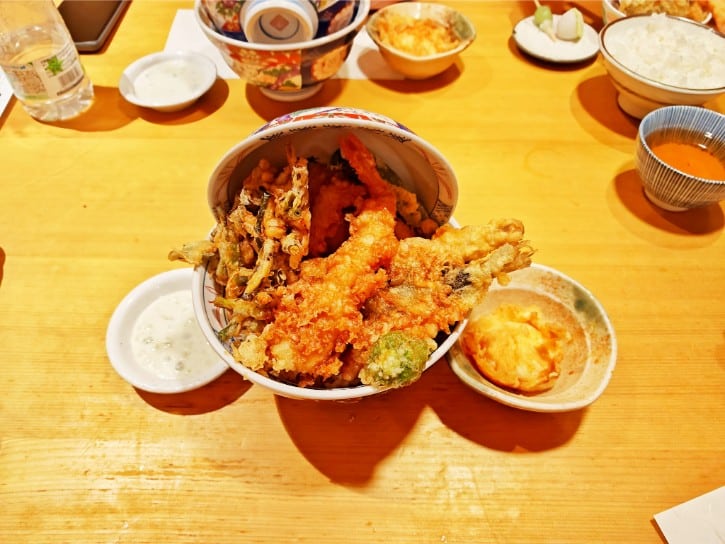
- What They Sell: They focus on tempura rice bowls, known as “tendon”. You’ll get crispy fried seafood and vegetables served on top of rice.
- Must-Try Dish: Try the Shoka Tendon. It has shrimp, fish, squid, and vegetables.
- Budget: Expect to spend around ¥1,500 to ¥2,500 per person.
- Take Note: This restaurant is very popular. You may need to write your name on a waiting list when you arrive.
b. Kunton Akutagawa
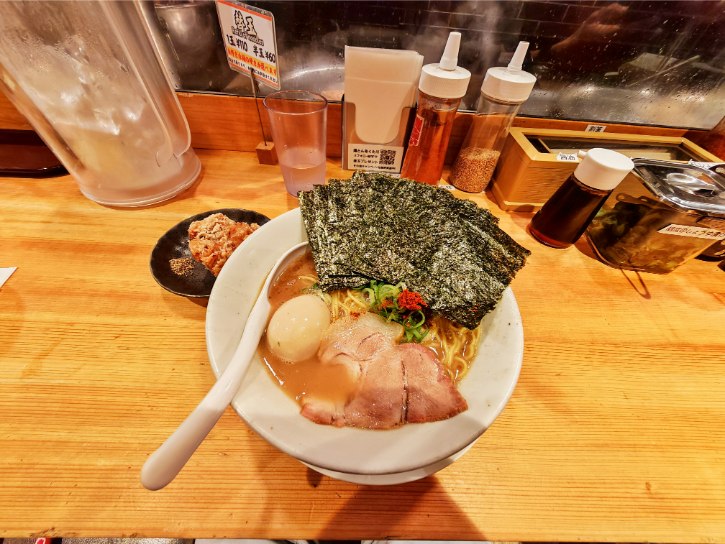
- What They Sell: Kunton Akutagawa specializes in hearty ramen dishes with various toppings. They also offer fried chicken (karaage), grilled char siu bowls, and set menus that combine ramen, rice, and side dishes.
- Must-Try Dish: Try the Topping Set (¥1,200), which includes ramen, crispy fried chicken, and your choice of extra toppings such as flavored egg, spicy sauce, bamboo shoots, cheese, or green onions.
- Budget: Ramen dishes range from ¥1,000 to ¥1,400. Meal sets that include ramen, sides, and toppings cost around ¥1,200 to ¥1,300. Side dishes and drinks are priced from ¥300 to ¥500.
How to Get to the Restaurants Listed Above from Kiyomizudera Temple
- Walk to Kiyomizu-michi bus stop.
- Take Kyoto City Bus No. 207 to Shijo Kawaramachi bus stop.
- From there, walk about 6 minutes to reach Tendon Makino Kyoto Teramachi or Kunton Akutagawa. Both restaurants are located very close to each other.
- The entire journey takes about 25 minutes and costs ¥230.
7:30 PM (Option 1): Shinkyogoku or Teramachi
a. Shinkyogoku Shopping Street
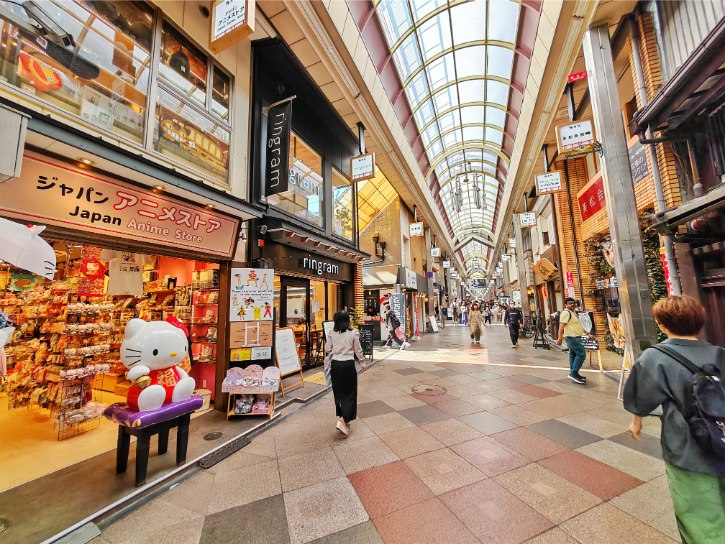
- What It Is: A covered shopping street in Kyoto, stretching about 500 meters between Sanjo and Shijo streets. It has over 170 shops, including fashion stores, souvenir shops, and street food stalls.
- Why Visit: You’ll find lots of different things in one place, from tasty Kyoto snacks like yatsuhashi and matcha sweets, to fun souvenirs like character merchandise and T-shirts. It’s also a great spot for street food. You can try ikayaki (grilled squid), castella manju (sponge cake filled with sweet paste), conveyor-belt sushi, and even visit a Cat Cafe.
- Atmosphere: It’s lively and crowded with tourists, students, and locals. The vibe is more casual compared to nearby Teramachi Street. Popular with young people, it offers trendy fashion shops, game arcades, and cat cafés.
b. Teramachi Kyogoku Shopping Street
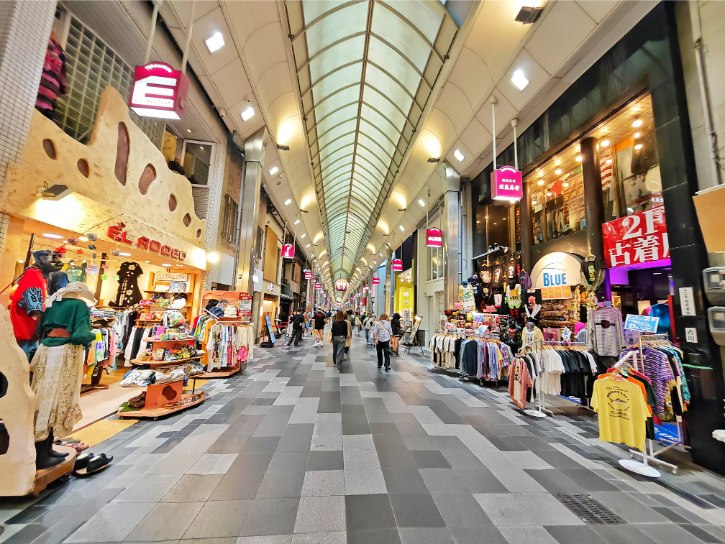
- What It Is: Teramachi Shopping Arcade is a covered shopping street in Kyoto. Here, you’ll find a mix of traditional and modern shops. They sell souvenirs, clothing, and local snacks.
- Why Visit: You can experience Kyoto’s history while shopping. Check out handmade fans at Hakuchikudo, and enjoy tasty local food at places like Kyo Tsuke-men Tsurukame and Moritoshi.
- Atmosphere: The arcade has a relaxed and friendly vibe, with colorful shop fronts.
How to Get from the Restaurants Listed Above to Shinkyogoku or Teramachi
Tendon Makino Kyoto Teramachi and Kunton Akutagawa are both located directly on Teramachi Kyogoku Shopping Street. Shinkyogoku Shopping Street is right next to Teramachi Kyogoku Shopping Street.
7:30 PM (Option 2): Shijo and Kawaramachi Streets
a. Overview
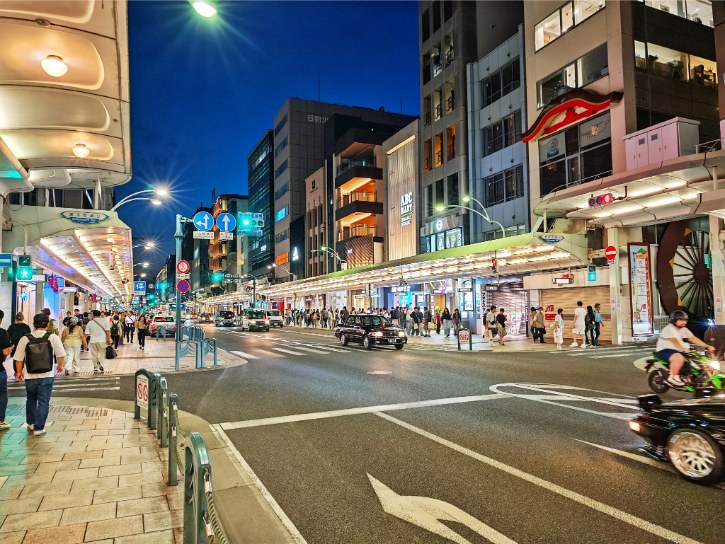
- What It Is: Shijo Kawaramachi is Kyoto’s main area for shopping and entertainment. It’s at the crossing of Shijo Street (east-west) and Kawaramachi Street (north-south).
- History: Shijo Street has been Kyoto’s main shopping area since ancient times. Kawaramachi Street started developing around the late 1500s. By the 1900s, this area became Kyoto’s busiest spot.
- Why Visit: It’s a lively place, especially in the evening. You’ll enjoy the bright lights, busy streets, shopping, dining, and energetic atmosphere.
- Atmosphere: The main streets are modern, lively, and busy with shoppers. You’ll see department stores and brightly lit shops along the streets.
b. High-End and Luxury Shopping
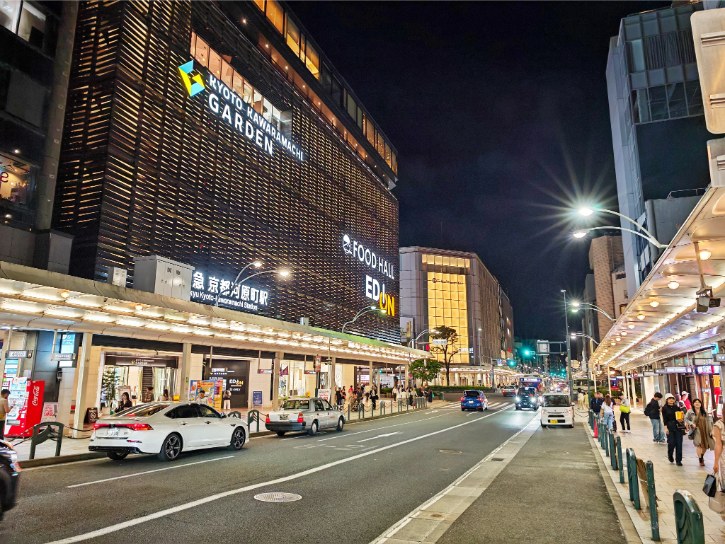
- Kyoto Kawaramachi Garden: A modern shopping mall near Takashimaya, offering stylish clothes and restaurants.
- Kyoto Takashimaya: A well-known, high-end department store at the main intersection. You can shop for luxury brands, makeup, souvenirs, and gourmet food. There’s also an official Nintendo Store with special merchandise.
- Daimaru Kyoto: Another upscale department store on Shijo Street. It sells luxury fashion, beauty products, and has a large food hall with delicious treats.
- Kyoto BAL: A trendy shopping center on Kawaramachi Street, with luxury boutiques in a modern and attractive setting.
c. Trendy Shops for Younger Crowds
- Fujii Daimaru: A popular spot for young shoppers, selling trendy clothes and unique products. Located on Shijo Street.
- Kawaramachi OPA: A multi-story shopping mall selling affordable fashion, accessories, and second-hand media. It’s popular with teenagers and young adults.
d. How to Get to Shijo and Kawaramachi Streets from Shinkyogoku or Teramachi
It’s just a 1-minute walk from Shinkyogoku or Teramachi to Shijo and Kawaramachi Streets.
9:00 PM: Heading Back to Osaka
a. Getting Back to Namba
i. Starting from Kyoto-Kawaramachi Station
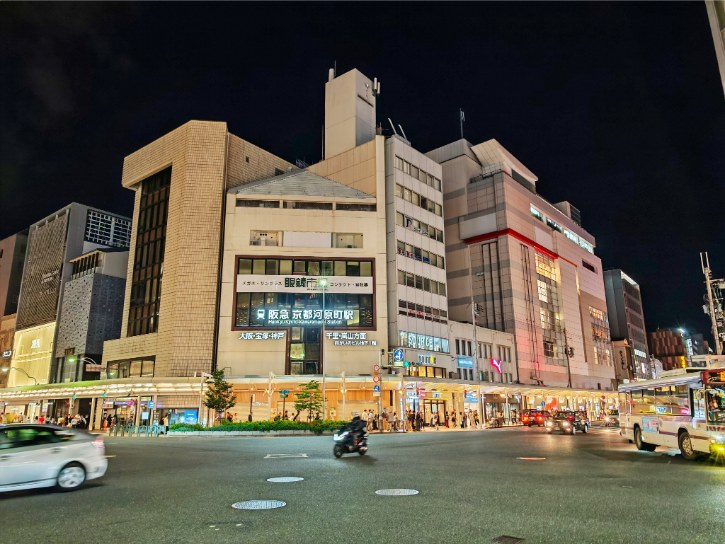
- At Kyoto-Kawaramachi Station, take the Hankyu Kyoto Main Line Limited Express train to Osaka-Umeda Station.
- When you reach Osaka-Umeda Station, walk to Umeda Station and transfer to the Osaka Metro Midosuji Line toward Namba.
- Stay on the train until you reach Namba Station.
- The trip takes about 55 minutes and costs ¥650.
ii. Starting from Gion-Shijo Station
- At Gion-Shijo Station, take the Keihan Main Line Rapid Limited Express or Limited Express to Yodoyabashi Station.
- When you reach Yodoyabashi Station, transfer to the Osaka Metro Midosuji Line going toward Namba.
- Stay on this train until you reach Namba Station.
- This trip takes roughly 55 minutes and costs ¥620.
b. Getting Back to Umeda
- At Kyoto-Kawaramachi Station, board the Hankyu Kyoto Main Line Limited Express train heading to Osaka-Umeda Station.
- Stay on this train all the way to the last stop, Osaka-Umeda Station.
- The journey takes around 42 minutes and costs ¥410.
Related Posts
Photo Credit:
Photos by PIXTA

